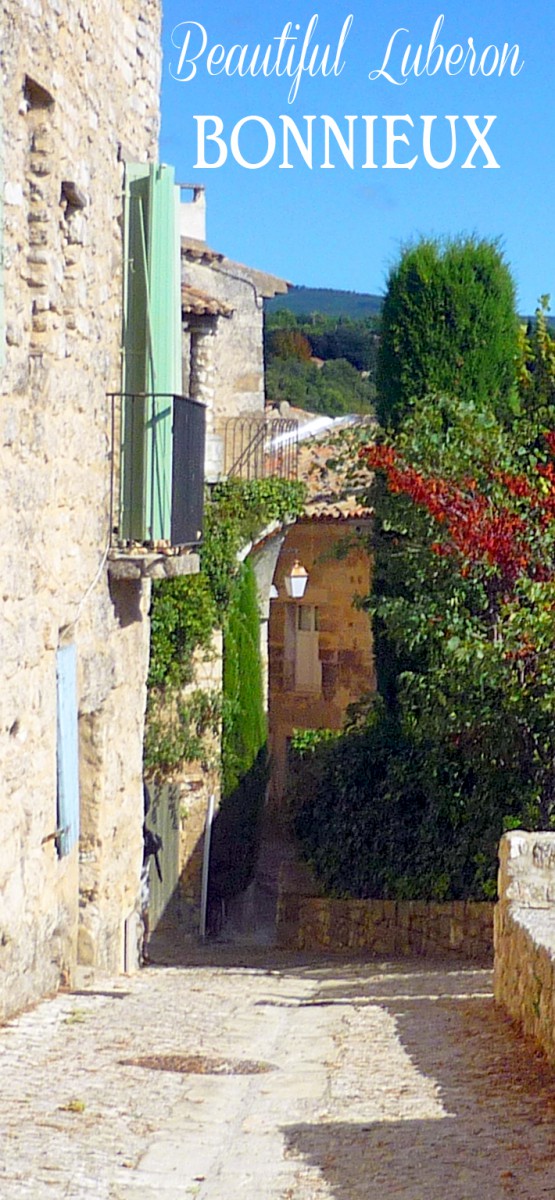During our last stay in Provence, I stumbled upon a hidden gem that left a lasting impression on me: Simiane-la-Rotonde.
Nestled in the Vaucluse Mountains, this charming village wasn't on my radar until we decided to venture further from our base in Bonnieux.
I must admit, I had never heard of Simiane-la-Rotonde before this trip, but its striking location and rich history quickly captivated me.
As we drove up the winding roads and caught sight of the village perched on its rocky promontory, I knew we had found something special.
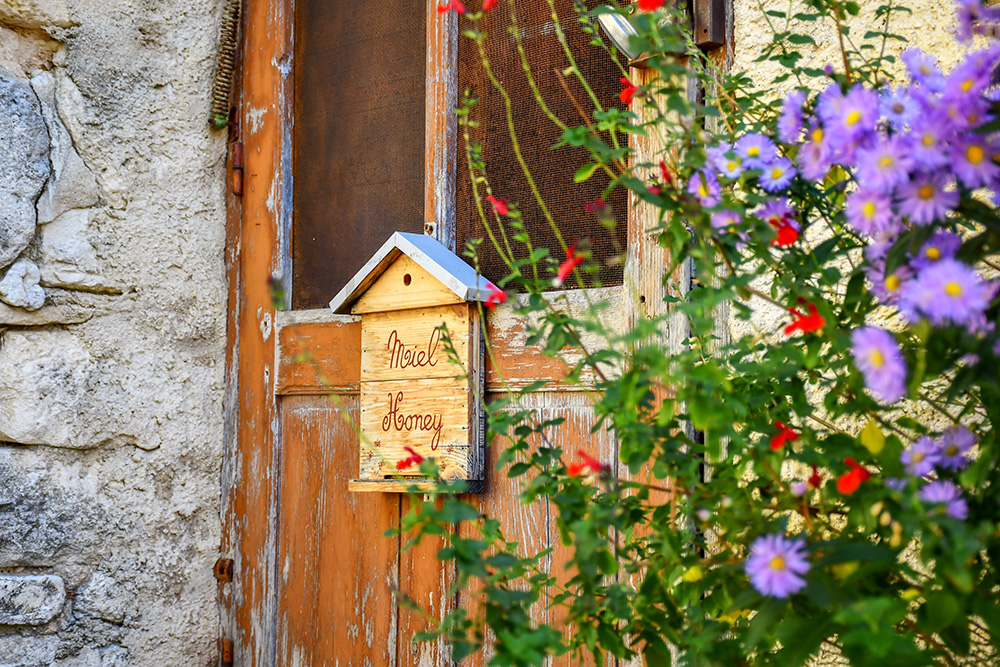
In the old village © French Moments
The combination of its medieval architecture, breathtaking views, and serene atmosphere made the journey well worth it.
Join me as I recount our delightful exploration of this remarkable village, where every corner holds a piece of history and every view is a postcard-worthy moment.
Watch this short video on the Luberon!
Plan your trip
- 🛏 Find the best accommodations in the Luberon on Booking.com
- 🚙 Rent a car in Aix-en-Provence or Marseille-Provence Airport
- 🙋♀️ Get the PASS CÔTE D'AZUR and take your pick from more than 100 amazing experiences!
- 🤩 Visit the beautiful Provençal region of Luberon
- 🚐 Join a 6-hour tour of Lourmarin, Bonnieux, Roussillon, and Gordes by air-conditioned minibus
- 🚘 Discover Provence in a 2CV. Stroll along exceptional roads and enjoy a piece of Luberon all to yourself!
- 🥗 Experience a black truffle hunting tour in a Luberon plantation
- 📚 Read the DK Eyewitness Provence and the Côte d’Azur Travel Guide
- 🗺️ Download the map of the village.
- 🚗 There are several parking spaces near the entrance to the old village. For example, try the car park of Place de la Combe.
Simiane-la-Rotonde: A Bit of History
Let’s step back in time as we recall the storied past of Simiane-la-Rotonde.
Ancient Origins and Medieval Power
Simiane-la-Rotonde is a village with a rich history, dating back to Roman times when it was located along a secondary route of the ancient Via Domitia, connecting Sisteron to Apt.
The village's name first appeared in the 11th century, derived from the Roman name "Simius," possibly meaning "domain of the monkey."
Throughout the Middle Ages, the village was under the control of the powerful Simiane-Agoult family, vassals to the Counts of Forcalquier.
They built their fortress on a rocky spur overlooking the plains, and their influence extended across a vast region from the Montagne de Lure to the Luberon.
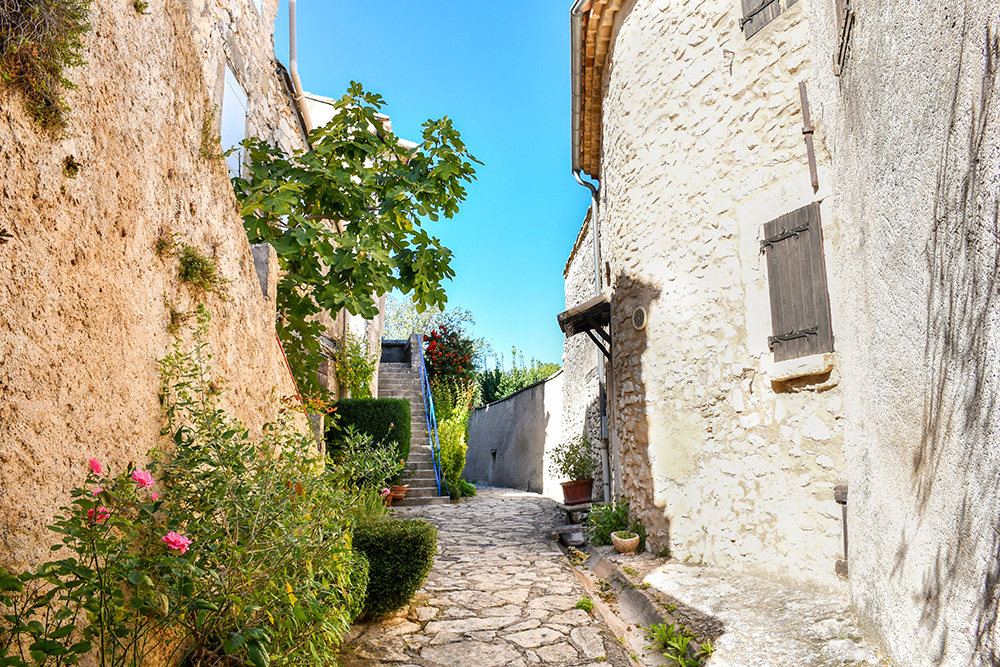
Rue du Barri © French Moments
Renaissance Prosperity and Glassmaking Legacy
Simiane-la-Rotonde prospered during the Renaissance, particularly due to its flourishing glassmaking industry, which began in the 14th century.
The village became known for its fine glassware, with production continuing into the 19th century, although the quality of glass declined towards the end of that period.
The village’s architecture reflects its historical prosperity, with grand homes and structures that have withstood the test of time.
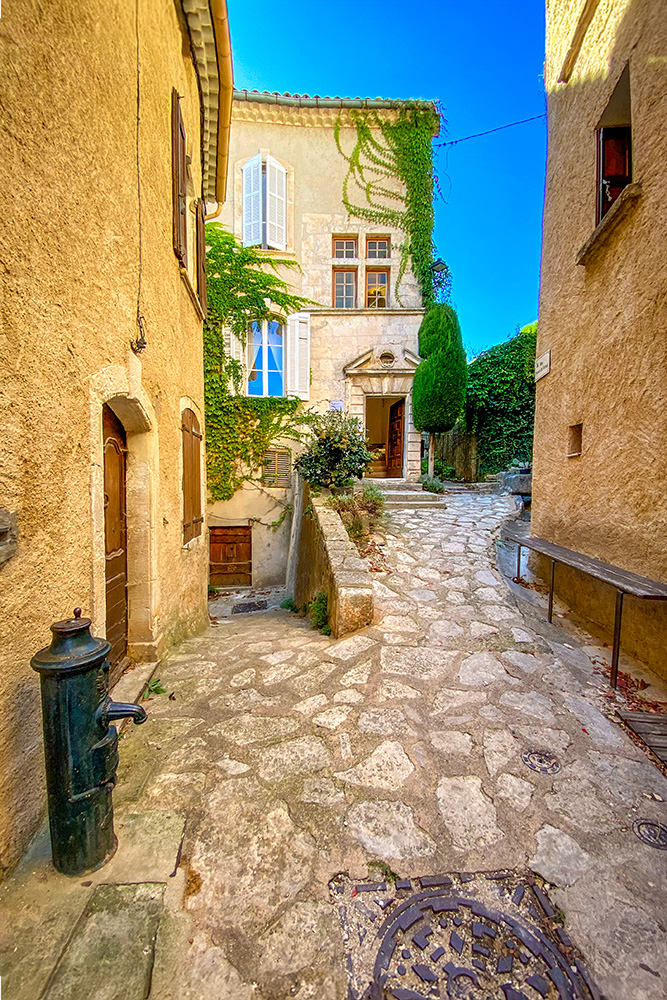
Rue Ponson du Terrail © French Moments
Turmoil and Transformation Through the Centuries
Throughout its history, Simiane-la-Rotonde witnessed several significant events.
In the 14th century, it was ravaged by bands of marauding lords, but the castle and Rotonde survived due to their strong fortifications.
During the French Revolution, the village saw a transfer of property from the nobility to the state, leading to the decay of many buildings.
In the 19th century, following the coup d'état by Louis-Napoléon Bonaparte, several residents were deported to Algeria for defending the Republic.
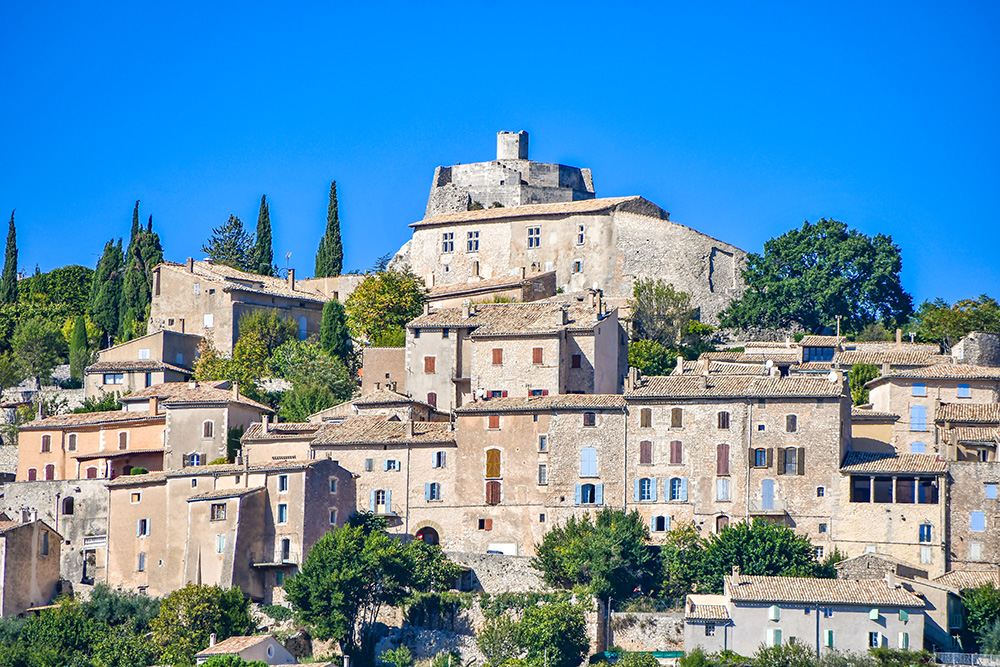
Simiane-la-Rotonde © French Moments
World War II Impact and Cultural Revival
World War II also left its mark on Simiane-la-Rotonde.
In 1944, a British bomber, returning from a mission, crashed near the village.
The crew, who perished in the crash, are commemorated by a monument in the area.
Today, Simiane-la-Rotonde is known not only for its historical significance but also for its cultural contributions, including an annual international festival of early music, held in the historic Rotonde since 1982.
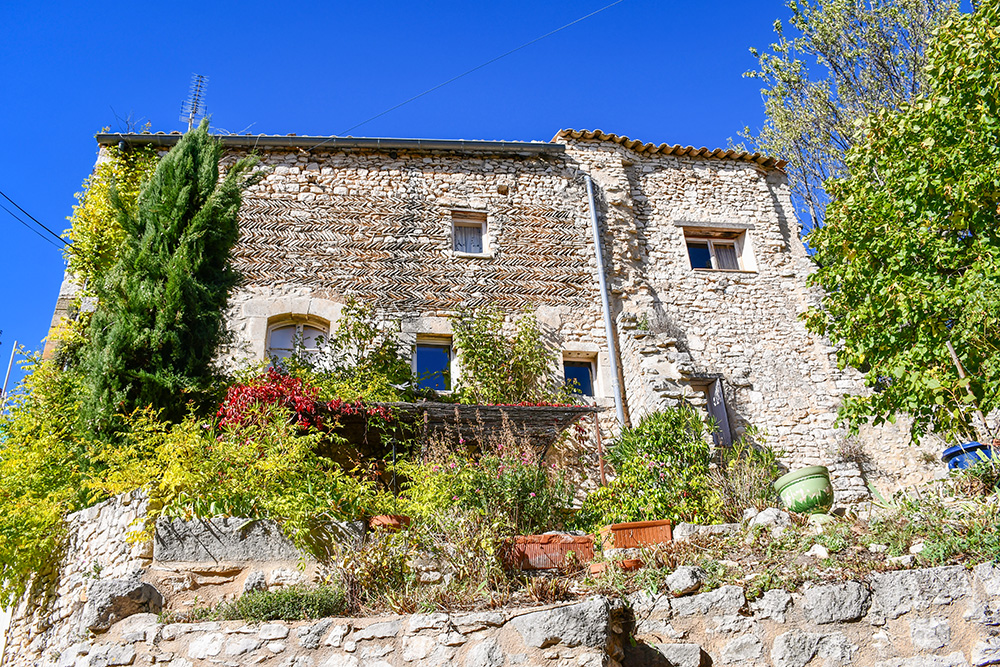
Simiane-la-Rotonde © French Moments
The Discovery Guide of Simiane-la-Rotonde
Here's some tourist information to help you explore the Provencal village.
🎦 Check out my guided walk on YouTube to explore Simiane-la-Rotonde with me:
Understanding the Village
Simiane-la-Rotonde is situated at over 600 metres altitude in the Monts de Vaucluse, in the Alpes-de-Haute-Provence département, on the border with the Vaucluse département.
The locality is 80 km from Avignon and Aix-en-Provence and 100 km from Marseille.
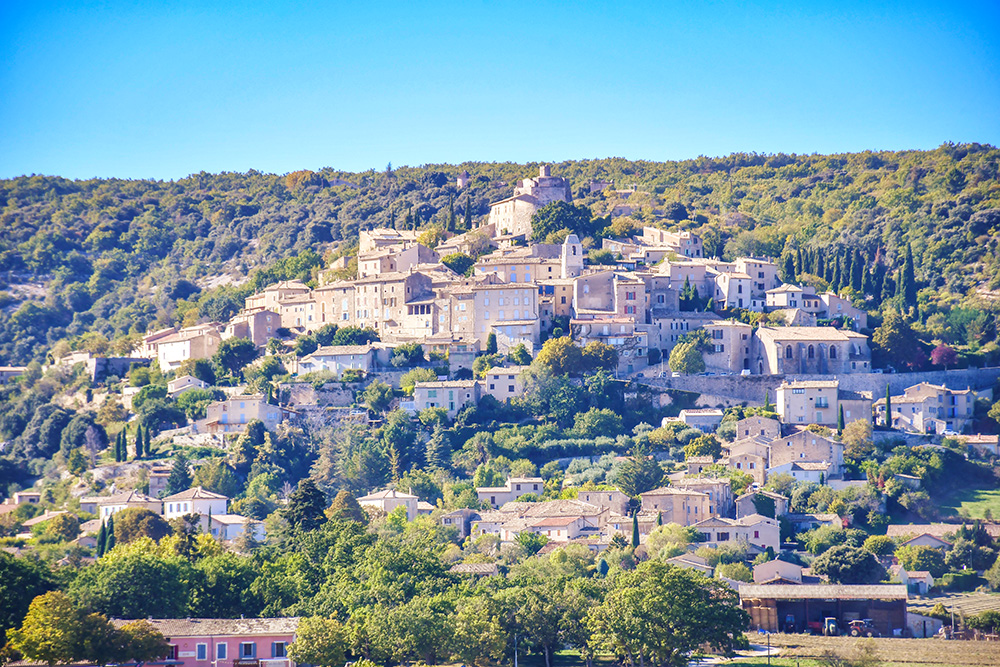
Simiane-la-Rotonde © French Moments
You get the impression of being at the end of the world, but everything is relative, as Apt and its shops are only 23 km away.
The village is only accessible on foot, and since the cobbled streets are steep, it is best to wear sturdy shoes.
This is not Gordes!
Simiane-la-Rotonde is sometimes confused with Gordes because of its acropolis-like appearance.
Indeed, there is a certain resemblance with Simiane's conical silhouette, with its stone houses clinging to the rock.
However, Simiane is much less frequented as it is off the main roads.
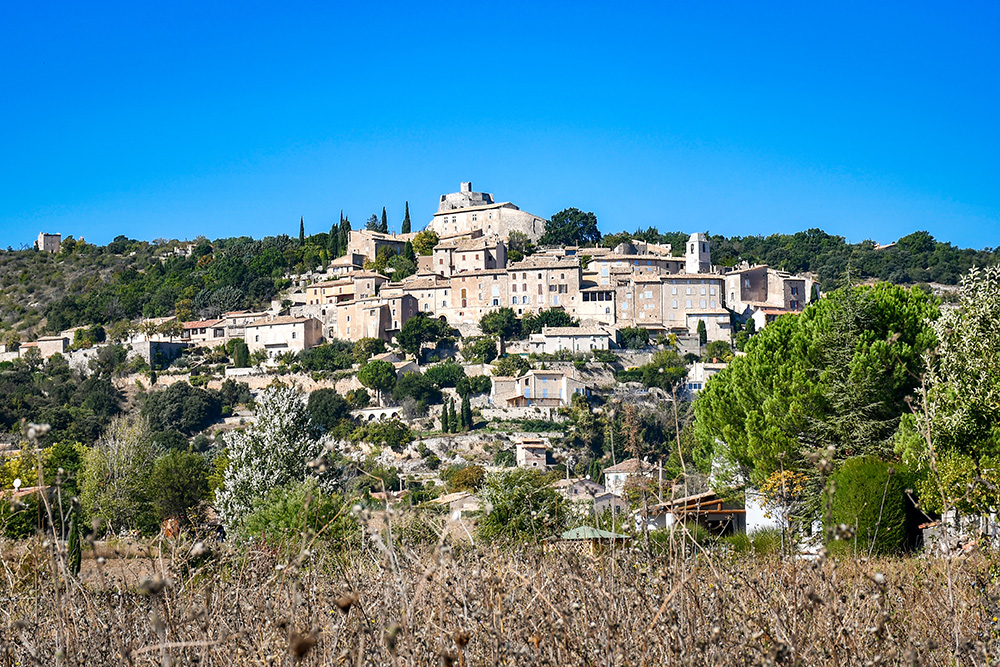
Gordes? Nope: Simiane-la-Rotonde © French Moments
The Village Walk of Simiane-la-Rotonde
Let's begin our exploration of Simiane-la-Rotonde from the Place de la Combe. This is where I parked my car as to avoid climbing the hill from the lower village.
Along the Rue du Rempart
From the Place de la Combe, follow the path of the ramparts by walking along the Rue du Rempart.

Rue du Rempart © French Moments
You'll be rewarded with magnificent views of the surroundings.
The Portail Neuf
You will reach the Portail Neuf, one of the medieval entrances to the village.
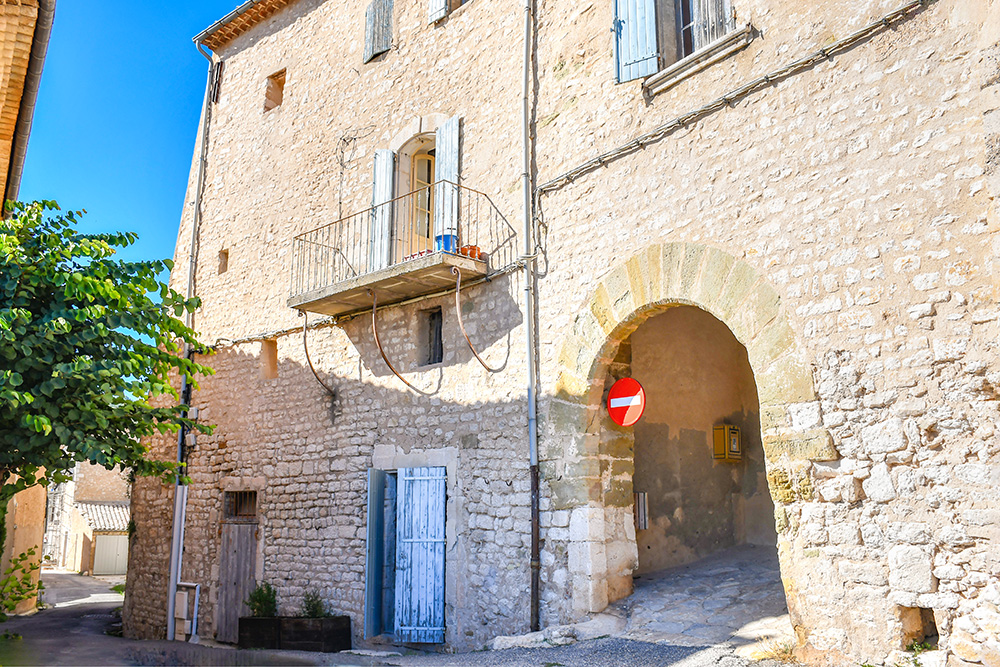
Portail Neuf © French Moments
Walk under it to access the heart of the historic village.
The 'Ostau': the Townhouses of Simiane
Throughout your visit, you will encounter grand townhouses that once belonged to the notable families of Simiane.

Townhouses in Simiane © French Moments
Here, they are called “ostau”, the Provençal word for a townhouse.
The cobbled and flower-lined streets are bordered by mullioned windows and elegant doorways.
Stone-carved lintels and diamond-panelled wooden doors adorn these homes.
They reflect the nobility and affluent bourgeoisie of glassmakers, notaries, lawyers, and doctors.
These professionals flourished from the 16th to the 18th century.
Some houses have plaques providing information about their history.

Townhouse plaque © French Moments
'Lo Grand Ostau'
Just after the Portail Neuf, you will catch sight of “Lo Grand Ostau,” Simiane's skyscraper with its six floors that belonged to the Eyroux de Ponteves family.
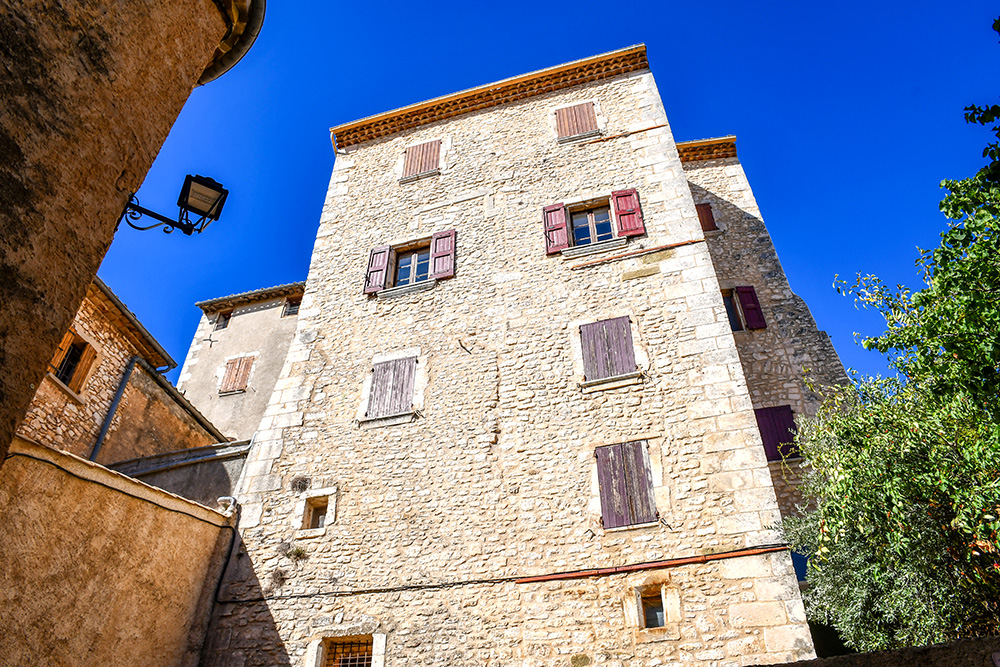
Lo Grand Ostau, Simiane's skyscraper © French Moments
Place Couverte
You will arrive at the Place Couverte, one of the emblematic places of Simiane-la-Rotonde.
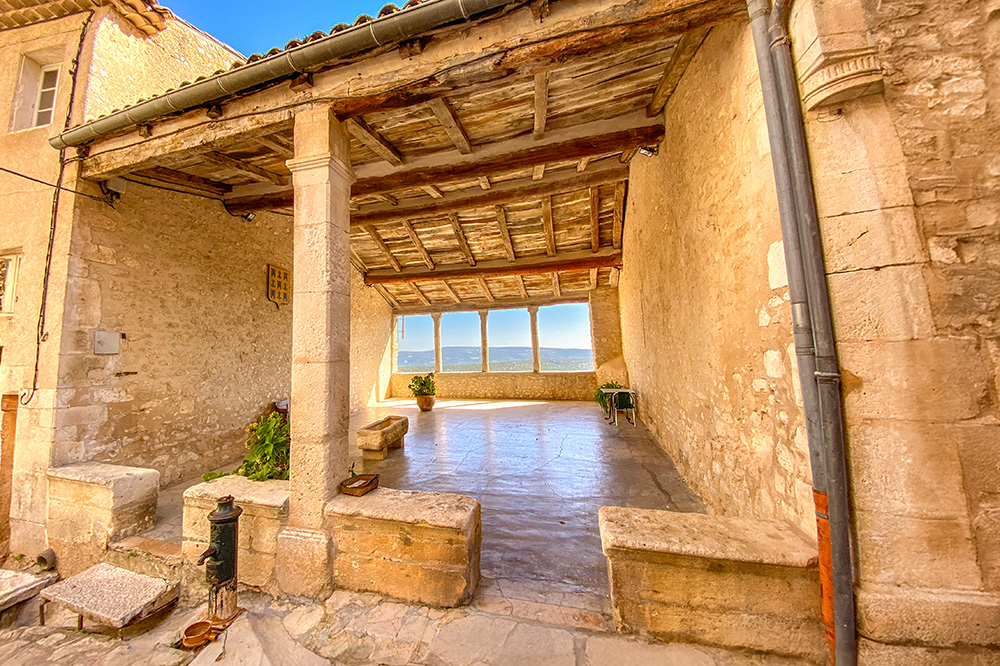
Place Couverte © French Moments
It is also called Place des Vieilles Halles because this is where the village market was held from the late 16th century.
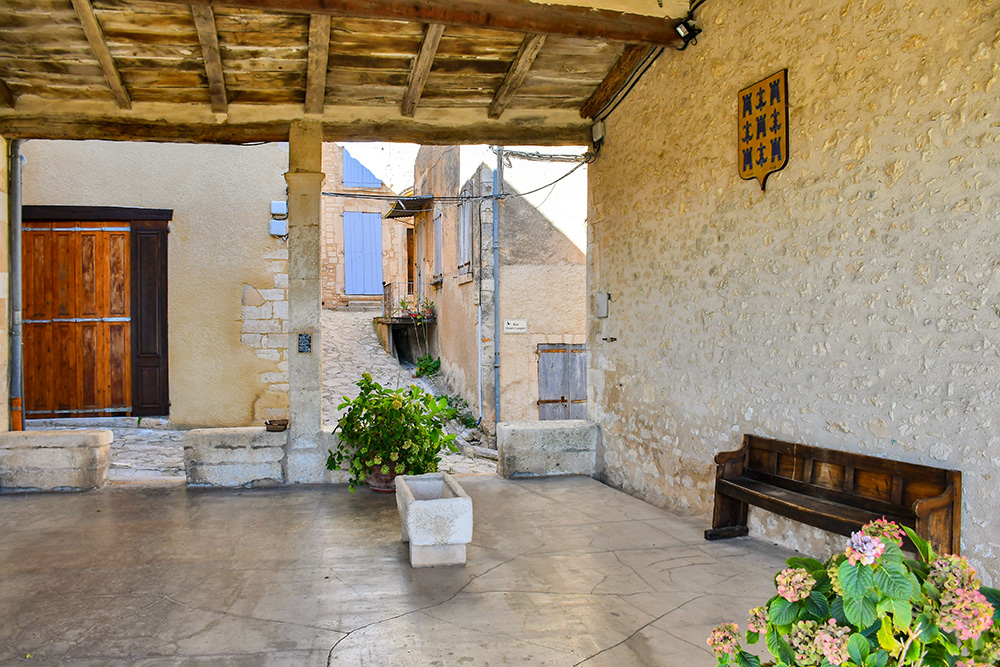
Place Couverte © French Moments
Here, exchanges were made under the watchful eye of the “Pezadou,” responsible for checking weights and measures.
The view here is breathtaking.
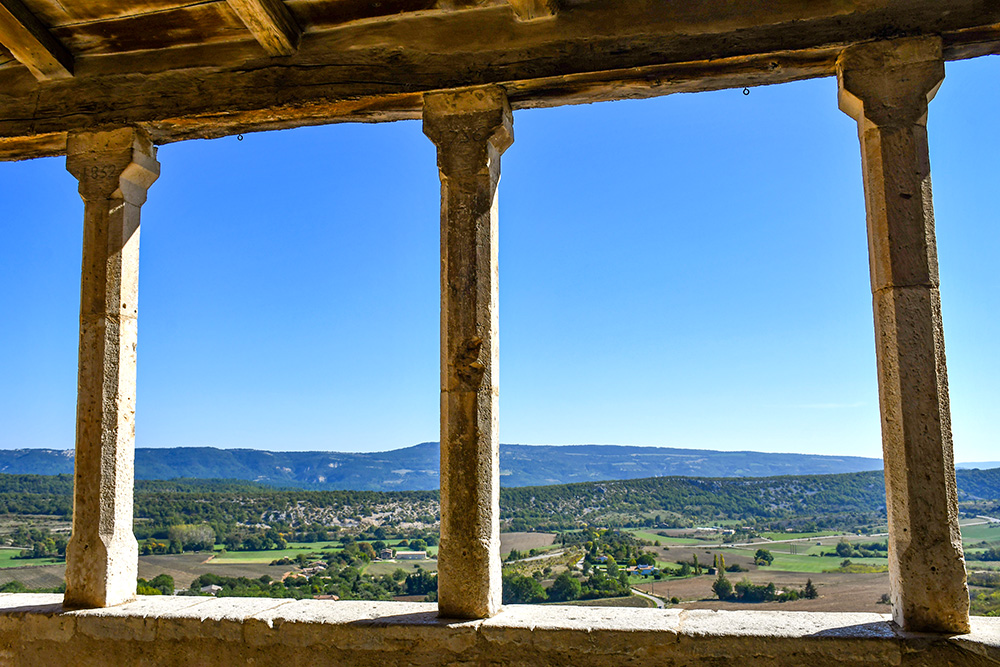
The view from the Place Couverte © French Moments
Clocher Saint-Jean
Next, climb up the Rue du Château, then the Rue du Clocher Saint-Jean.
You will pass by the Clocher Saint-Jean.
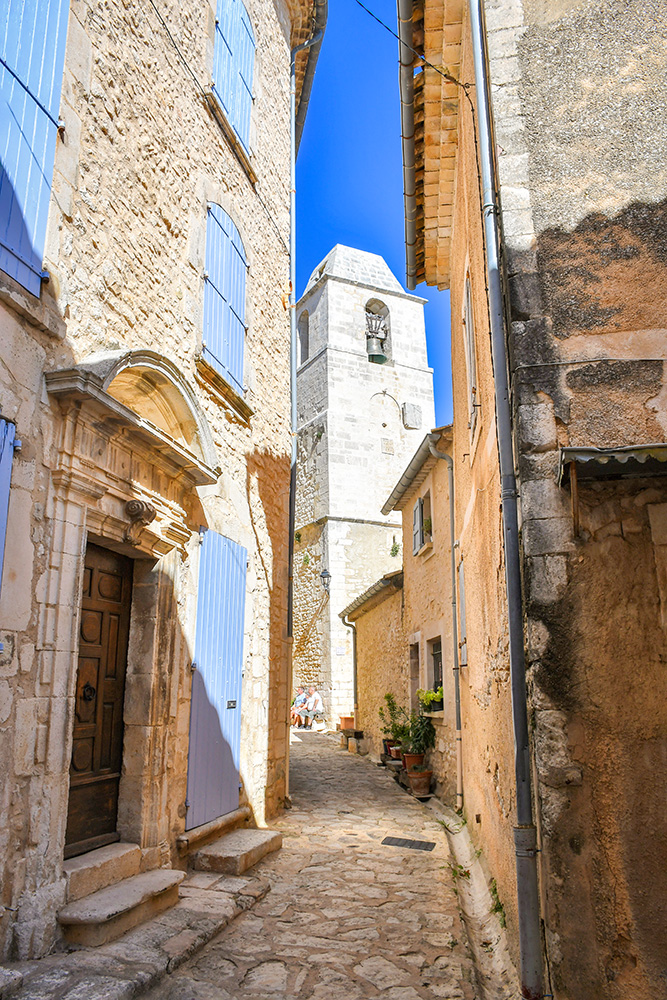
Rue du Clocher Saint-Jean © French Moments
This bell tower is the only remaining vestige of the old Saint-Jean chapel, which was destroyed in the 19th century.
It serves as the village belfry, and its bell has been marking the hours for the villagers for four centuries.
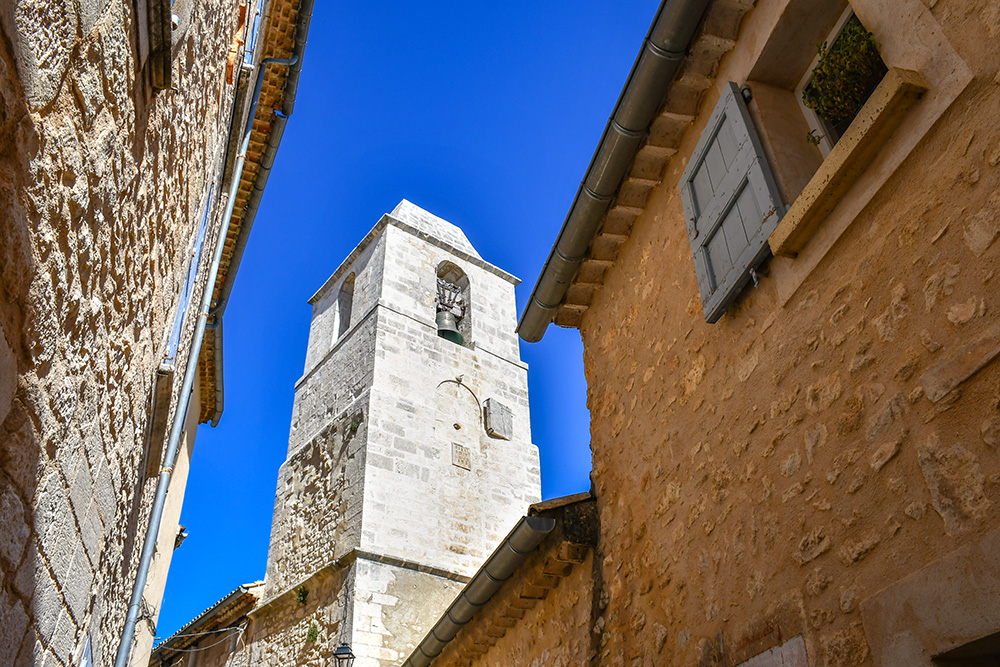
Clocher Saint-Jean © French Moments
The Catholic parish church Sainte-Victoire is a bit further down and was built between 1520 and 1623.
The Calades
Take this cobbled path to the left.
You can see on the left of this Calade Rue Jean Giono that a gutter has been built to channel rainwater.
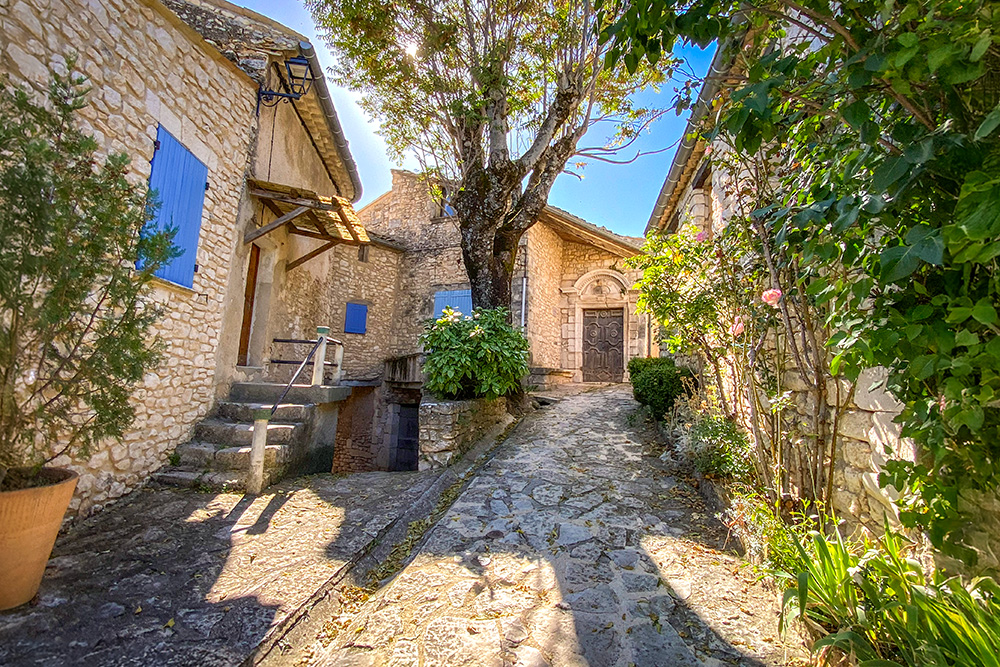
Maison Pellissier des Granges © French Moments
There is the superb ornate door of the Maison Pellissier des Granges, a grand townhouse from the 16th and 17th centuries.
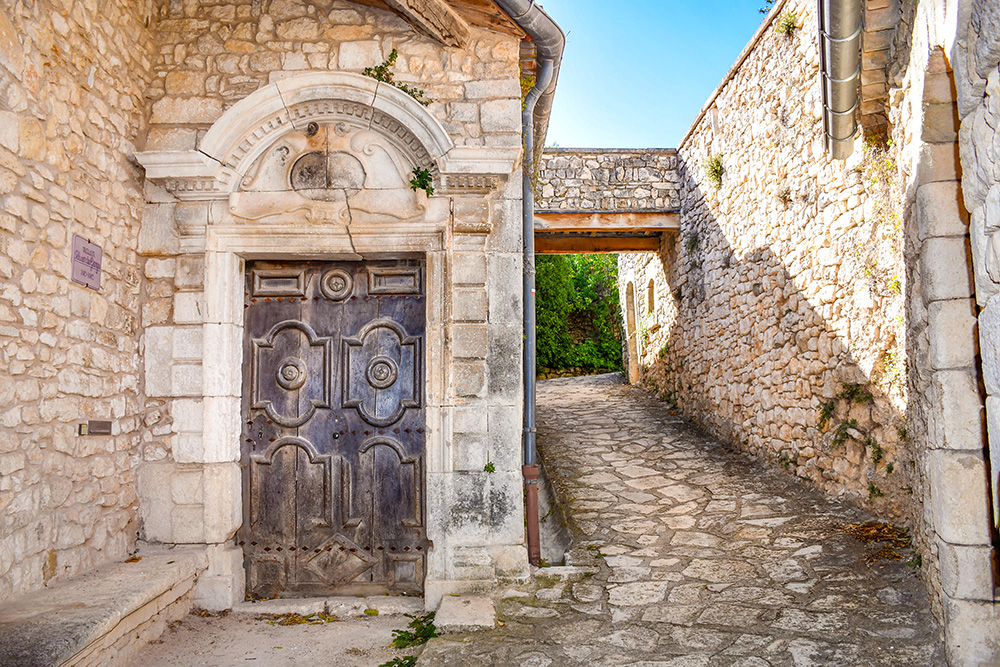
Maison Pellissier des Granges © French Moments
Continue along the Rue du Barri, which runs alongside ruined houses.
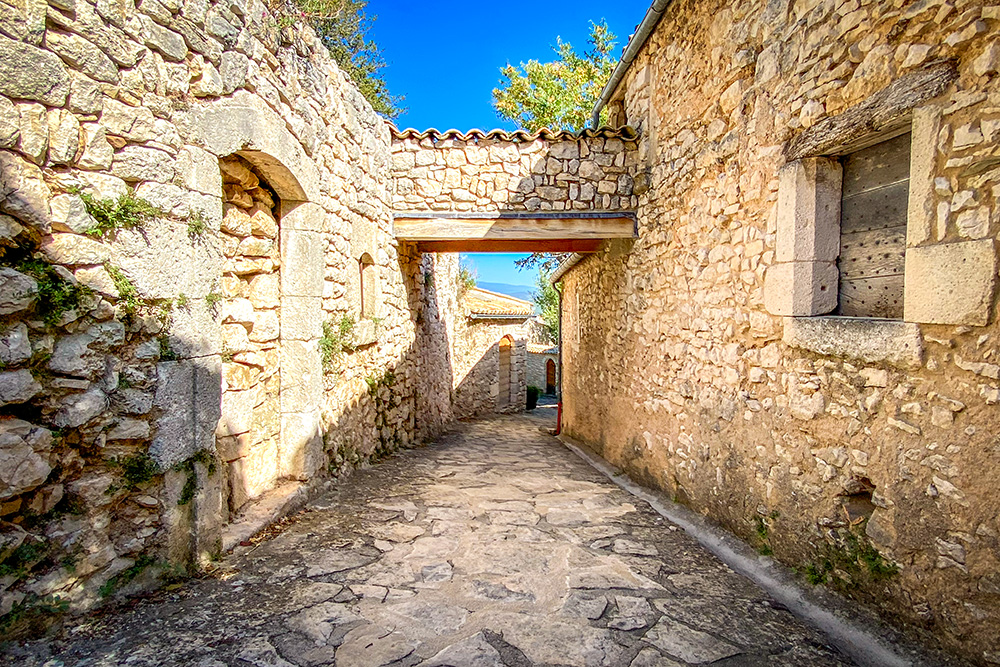
Rue du Barri © French Moments
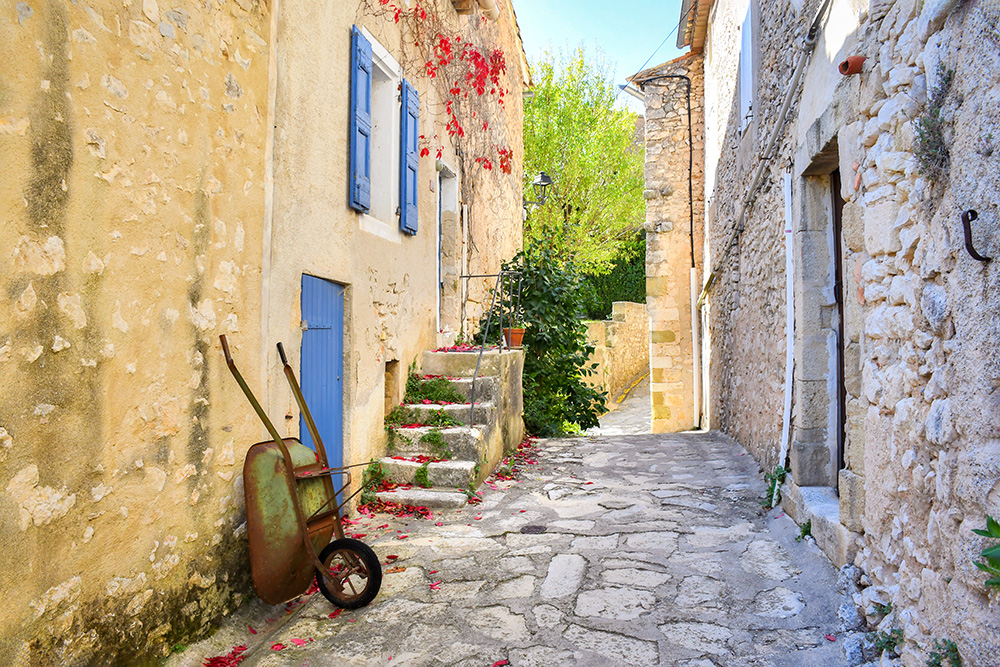
Rue du Barri © French Moments
We now join the Rue du Château, which, as its name suggests, leads to the castle.
The Castle's History
Pass under the Porte des Moulins, the Mills Gate to reach the top of the village.

Porte des Moulins © French Moments
You will see the exterior of the castle and admire the Rotonde.
This structure is unique as it is the oldest circular keep in Provence.
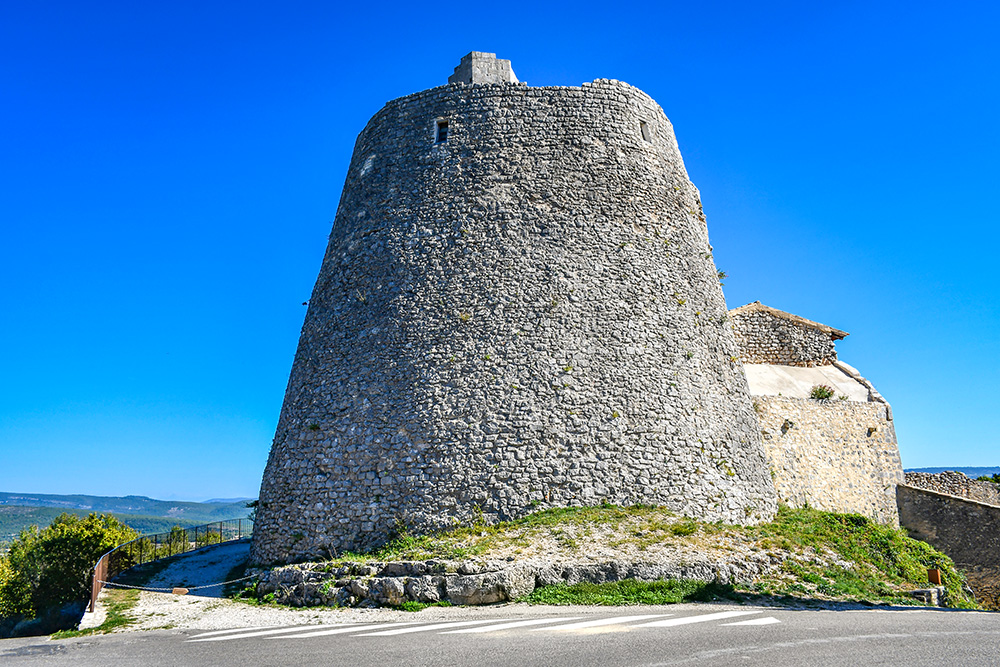
The Rotonde of Simiane © French Moments
It contains a magnificent room that we will see later.
The castle belonged to the Agoult-Simiane family.
This influential family was among the most powerful vassals of the Counts of Forcalquier and the Counts of Provence in the Middle Ages.
The castle dates back to the 11th century and was permanently inhabited by the Agoult-Simiane dynasty until 1567.
Go down to the entrance to the castle.
The Castle's Terrace
Entrance to the castle is subject to a fee.
From the terrace of the castle, there is a breathtaking view over the village rooftops and the surrounding countryside.
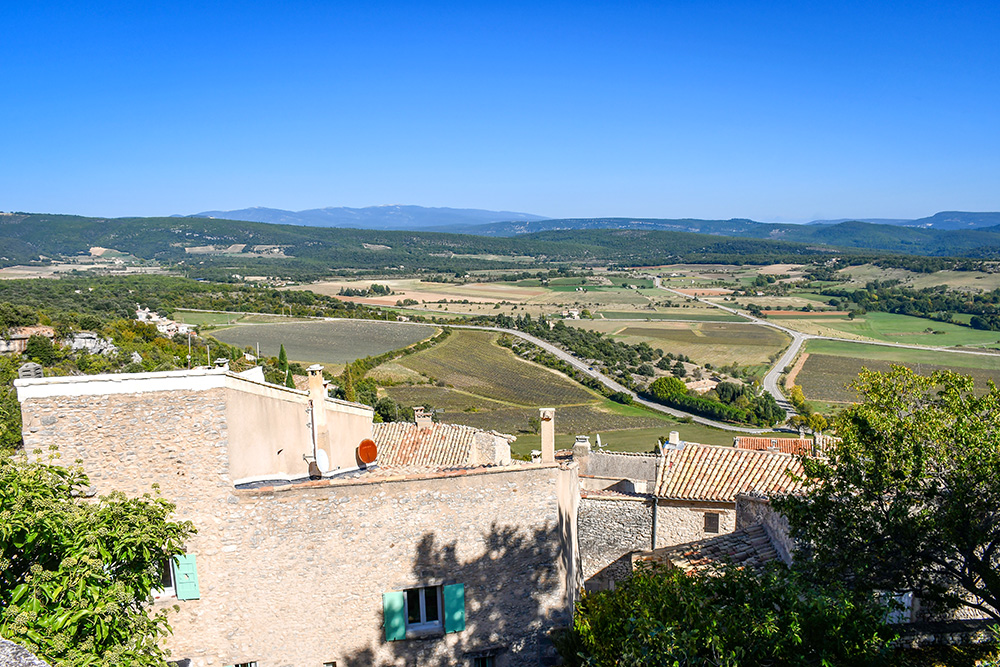
The view from the Castle of Simiane © French Moments
Beyond the plain of Simiane, you can see the Montagne de Lure, which marks the horizon.
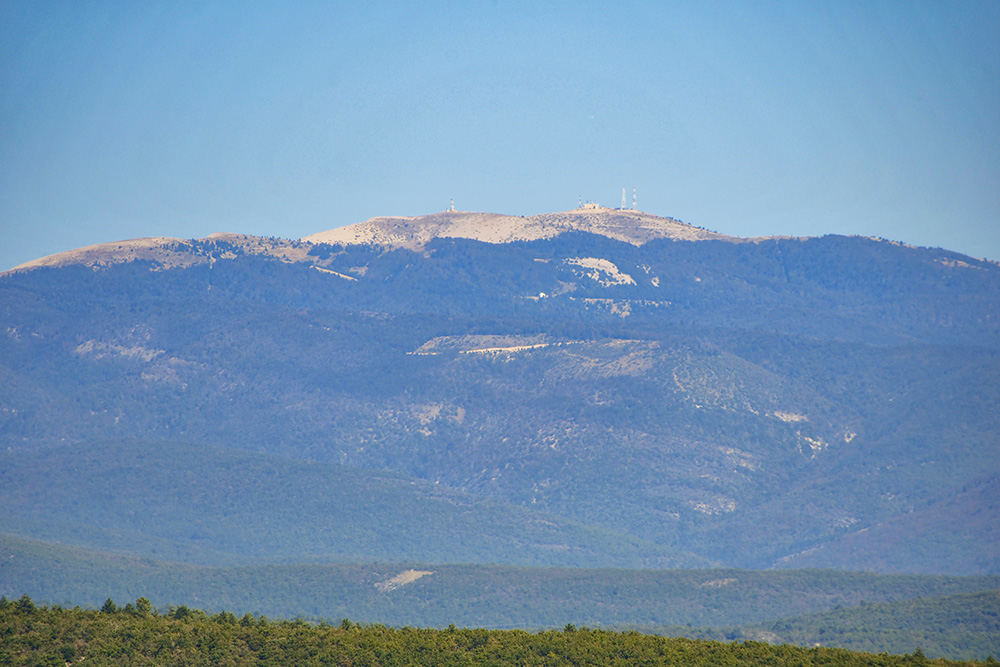
View of the Montagne de Lure from the Castle © French Moments
On the other side of the castle's inner courtyard stands the famous circular keep of the Rotonde.
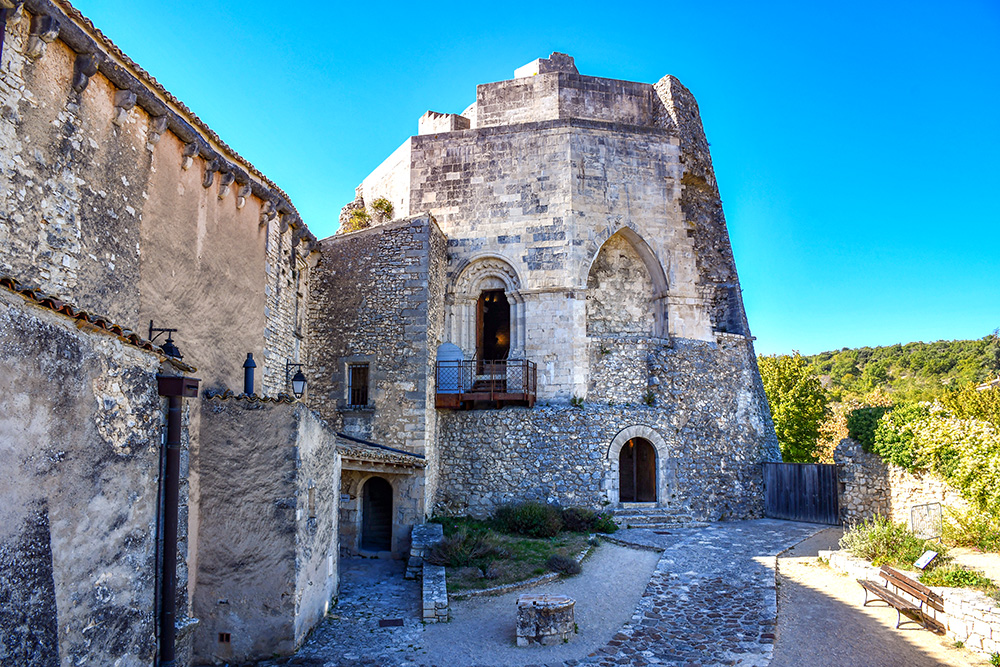
The Rotonde keep of Simiane © French Moments
The Rotonde
Go inside the Rotonde.
The first room is a low, sober, and dark place which must have served as a warehouse, cellar, or armoury.
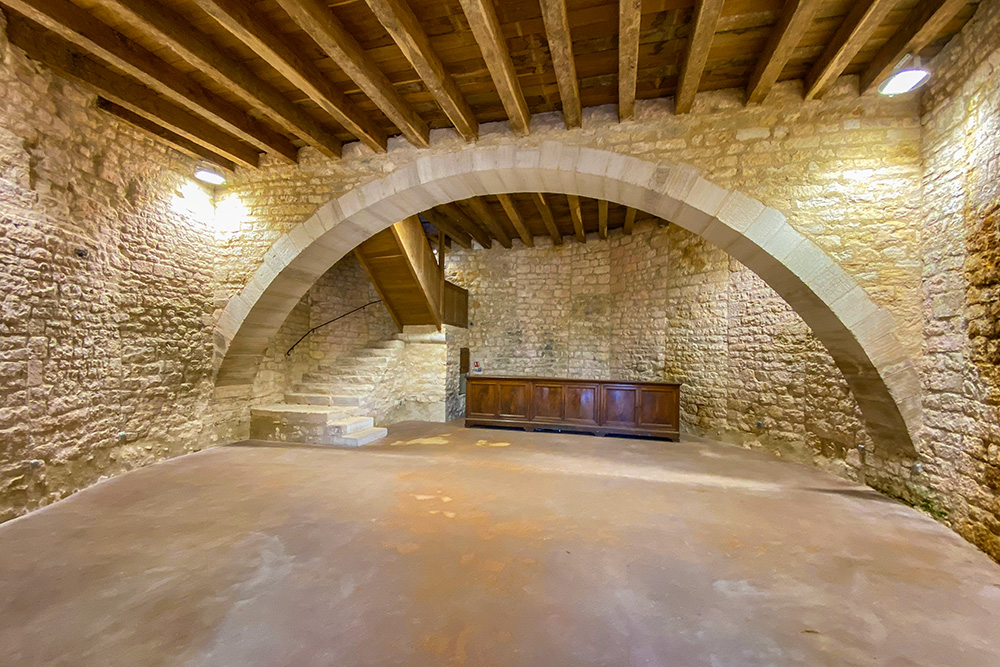
The lower room of the Rotonde © French Moments
Take the stairs to access the rotunda room.
And there, it is a marvel.
Admire this superb Romanesque room with its ribbed dome nearly 10 metres high.
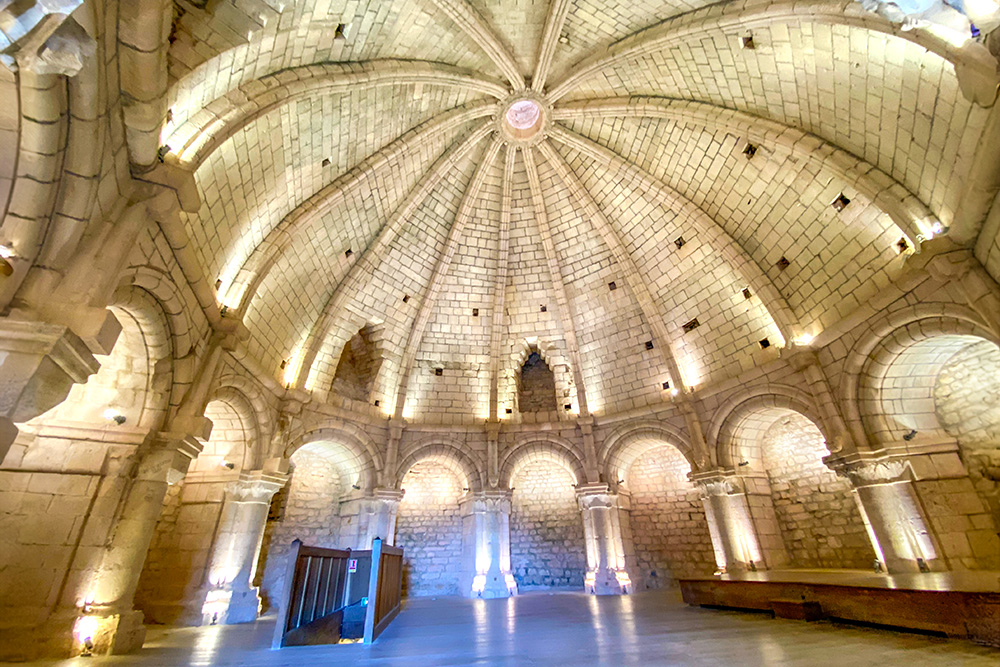
The Rotonde of Simiane © French Moments
This surprisingly beautiful dome is enigmatic.
Indeed, the original purpose for which this room was built remains unknown as there are no existing archives on the castle.
This has long been controversial, and one can only speculate.
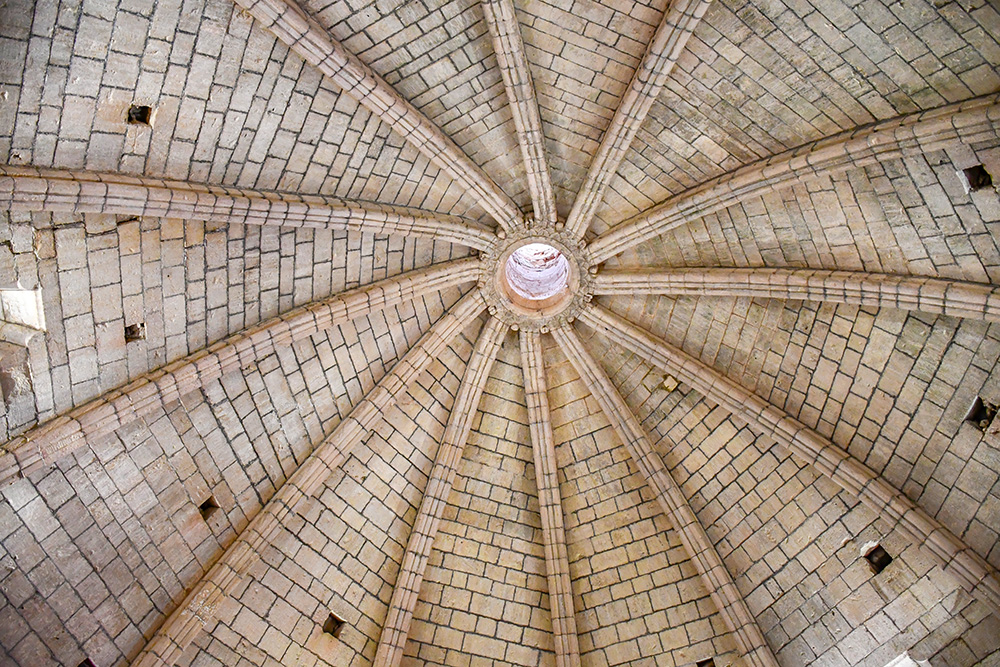
The Rotonde of Simiane © French Moments
Twelve arcatures form niches, and the capitals of the small columns are adorned with masks.
There are strange characters: men, animals, and monsters.
You can recognise a monk's head, a bearded devil, and even a gagged man.
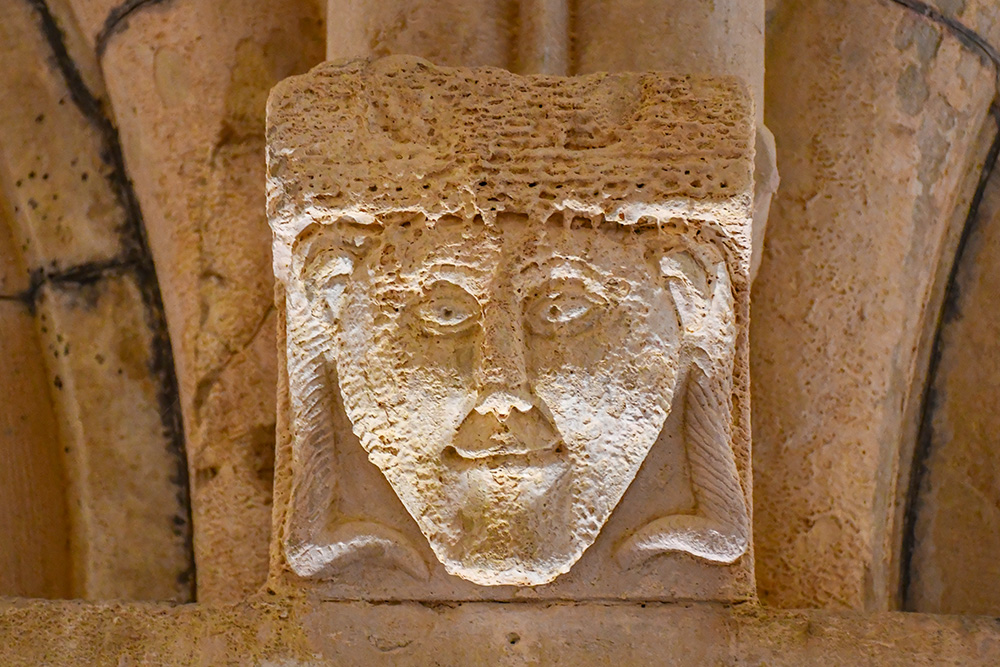
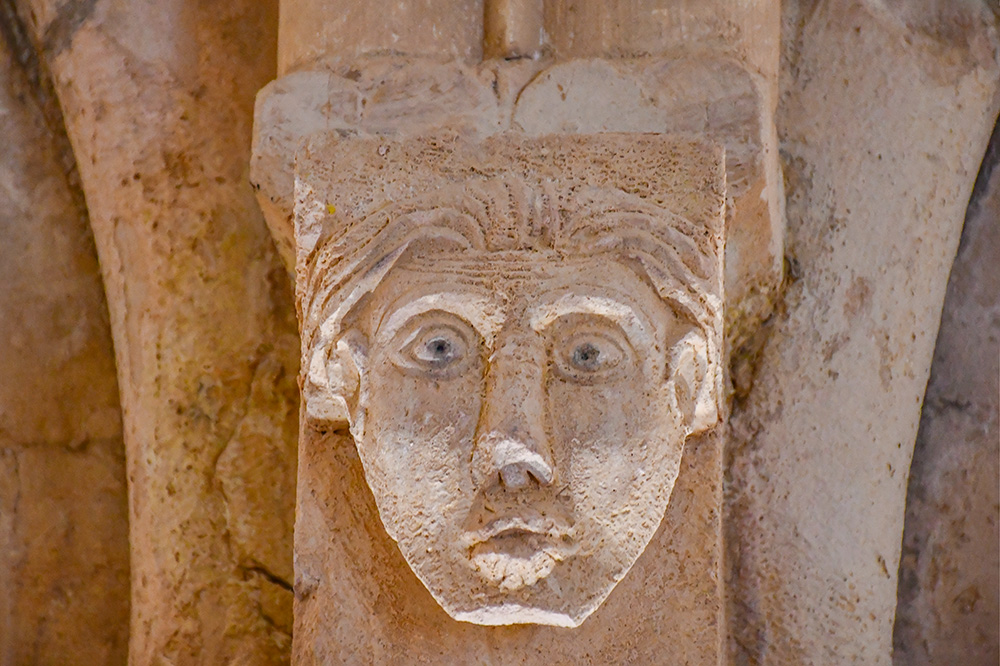
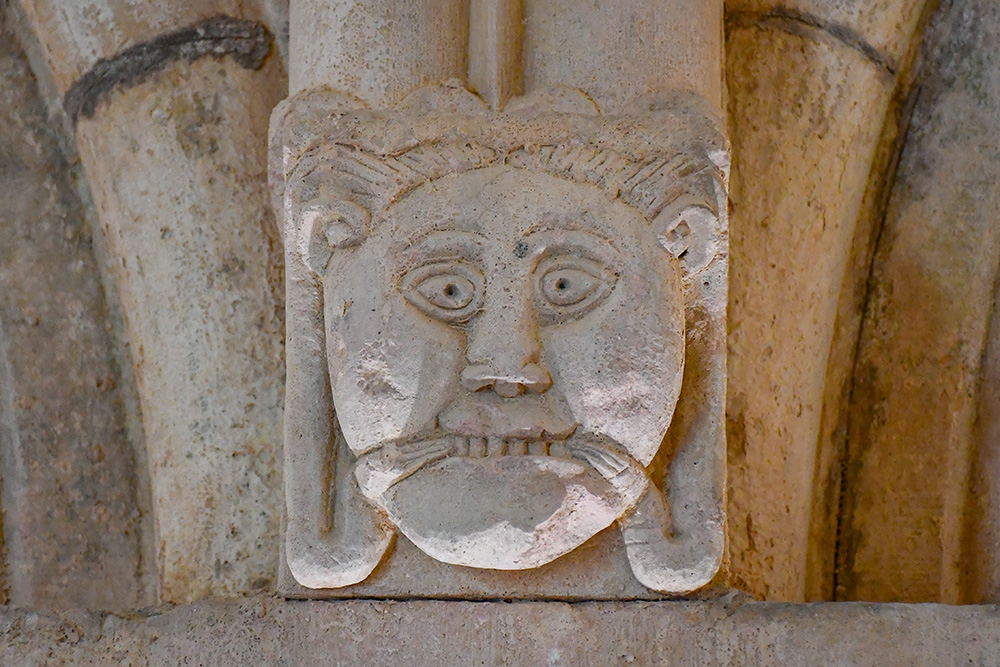
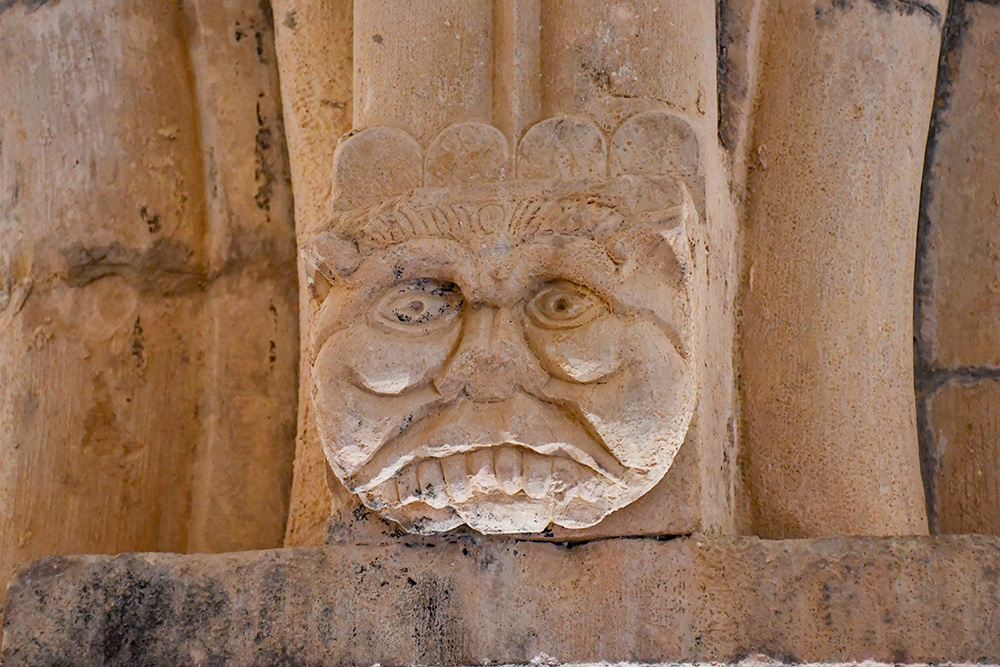

The Castle's other rooms
During the castle tour, you will discover other rooms, including a 14th-century Romanesque hall and the Renaissance apartment.
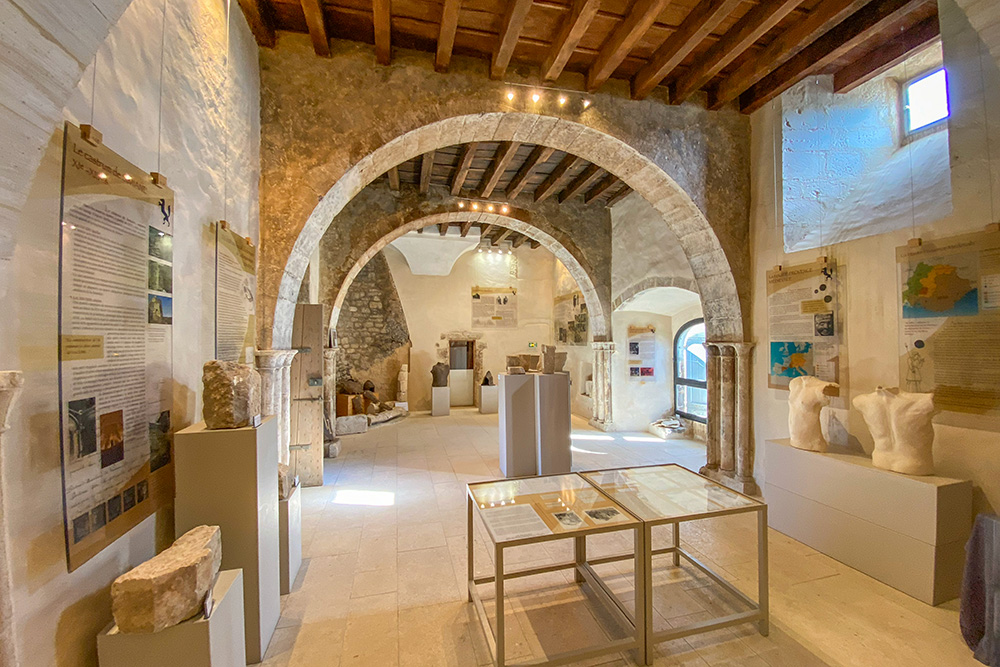
The historic exhibition © French Moments
You can reach the upper floor of the south wing via the balcony by the Romanesque entrance door of the Rotonde.
A 16th-century spiral staircase also leads to three rooms that once served as an apartment.
These rooms were designed in the Renaissance style by Louis d'Agoult-Montauban for his family.
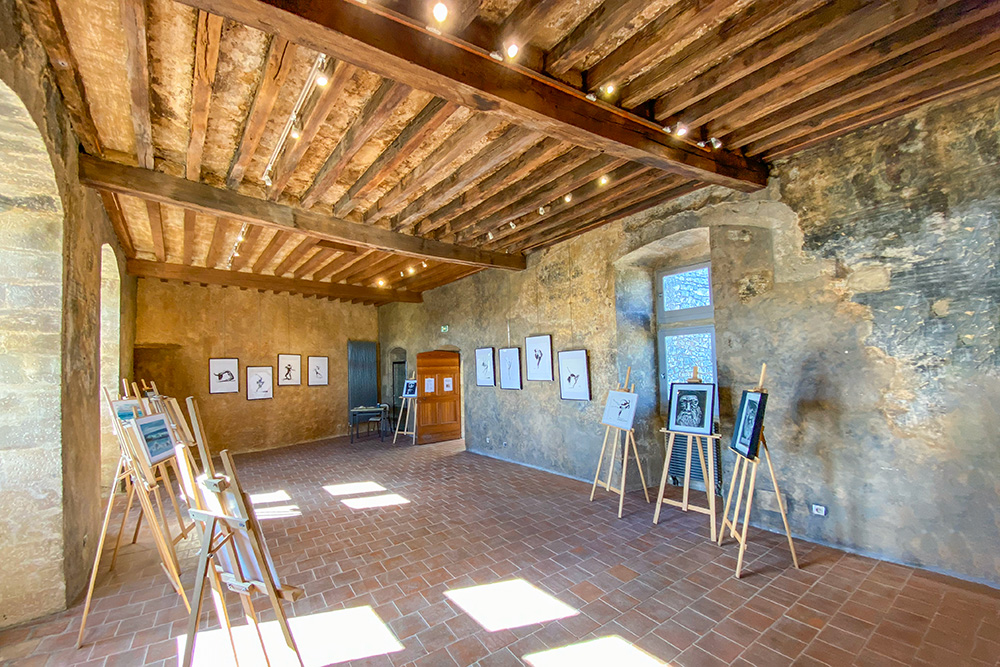
The Renaissance apartments © French Moments
The three connected rooms, lit by large mullioned windows, included a reception room, a bedroom, and a dressing room with a small washroom.
Today, the space is dedicated to aromatherapy, occupying the last two rooms.
Visitors can enjoy a selection of essential oils and pleasant scents.
The descent through the village's cobbled streets
Continue your visit to Simiane-la-Rotonde by descending the village’s cobbled streets back to our starting point.
You still have a few lovely spots to visit.
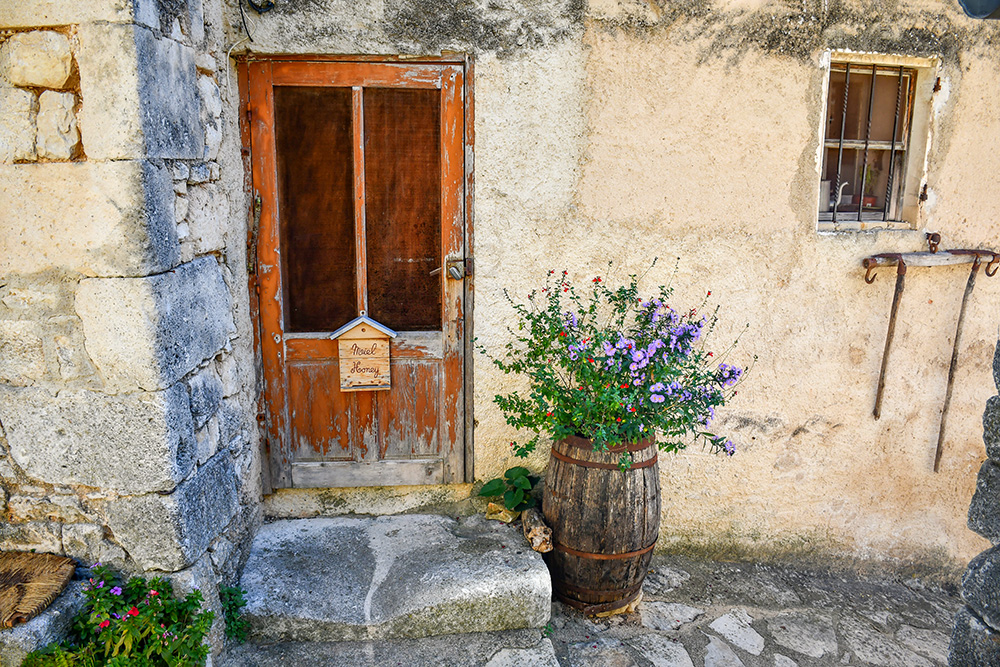
In the Calade of L'Andrône © French Moments
Down the shaded cobbled path, you will reach another grand townhouse of Simiane: the Maison Dumaistre.
Dating from the 16th and 17th centuries, it is now a guesthouse.
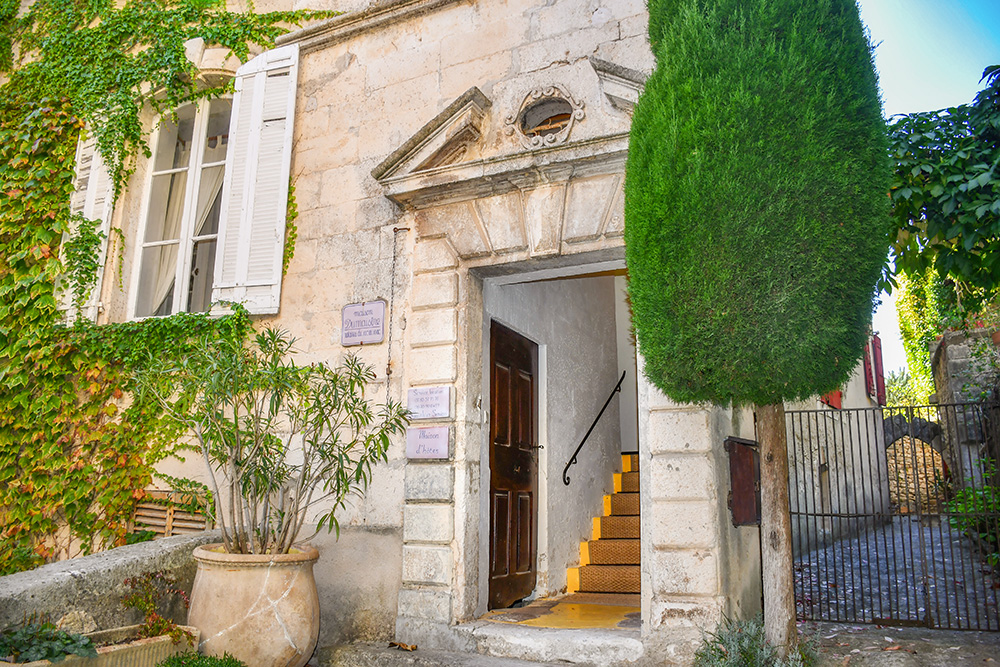
Maison Dumaistre © French Moments
To the left, you will glimpse Simiane's famous 'skyscraper'.
You are now back at the Portail Neuf.
All you need to do is follow the Rue du Rempart to return to the starting point.
Find out more
Here are some pages from our blog and other websites to find out more about this Provencal destination.
- Discover the hilltop villages of the Luberon
- Explore the neighbouring villages of Saint-Saturnin-lès-Apt and Viens
- Find out more about Provence-Alpes-Côte d'Azur
- The official tourist office of the area
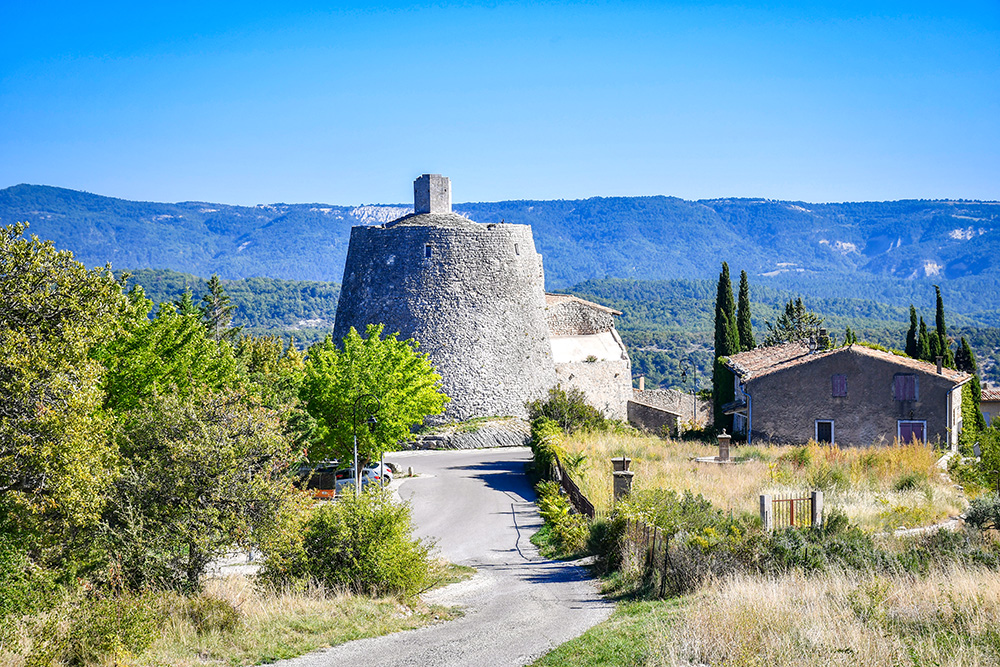
The Rotonde of Simiane © French Moments
Where to stay near Simiane-la-Rotonde
Simiane-la-Rotonde and surroundings have a high capacity for holiday accommodation. The commune and its surroundings has hotels, bed and breakfasts (covering all price ranges), estate agencies offering seasonal rentals and gîtes.
Click here to book your accommodation in the Luberon or browse the map below:
What to do in the Luberon
Be inspired by a list of things to do in the Luberon:
Pin Simiane-la-Rotonde on Pinterest
